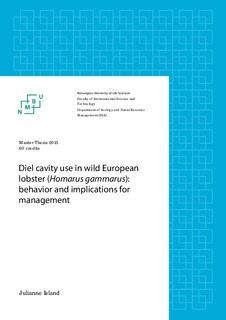| dc.description.abstract | Knowledge and understanding of an animal’s diel activity and temporal and spatial positioning within a habitat is important if we want to understand the pattern behind an animal’s movement and behavior. Information about normal behavior and activity in the field is vital for managing the species. From the 1950s through the 1970s, there was a dramatic decline in the catches of European lobster (Homarus gammarus). The number of lobsters is now so low that the species is registered as “near threatened” on the Norwegian “red list”. In this study, diel cavity use was analyzed in relation to season and environmental factors such as water temperature and light conditions. Further, I explored patterns of cavity use throughout the day for two years. A custommade cavity was placed at ca. 20 m depth in the Outer Oslofjord and monitored with a CCD camera from November 2012 to November 2014. For each lobster observed, activity was recorded as entering or exiting the cavity, time entered or exited, and under what light conditions the activity occurred. Data analysis using generalized linear mixed effect models (GLMM) and linear mixed effect models (lme), showed that the lobster was most active under low light conditions and that lobster activity level was positively correlated with water temperature. Also, the overall impression was that there was a higher activity level in the summer and early autumn, and a drop in the activity through the winter. As the lobster’s activity is correlated with temperature, climate change with corresponding rising sea temperatures might lead to changes in lobster behavior and refugee use. The possible resulting changes in catchability and the effect it will have on the exploitation of lobster stocks should be further explored to ensure a sound foundation for decision making, and potentially make changes in the duration of today’s fishing season. | nb_NO |

